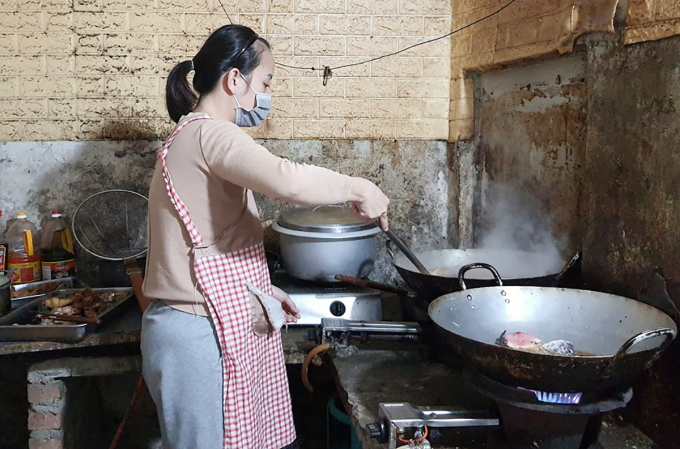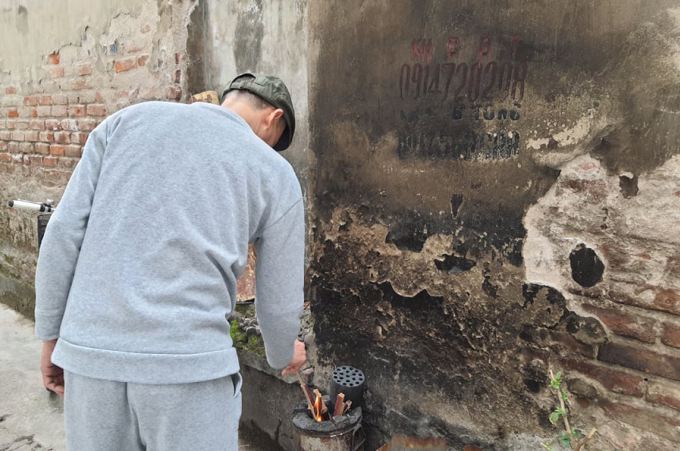Tran Thi Van, an eatery owner in Hanoi, is struggling to even pay rent after cooking gas prices skyrocketed.
Managing three big woks in the kitchen at her stall in Cau Giay District last Friday, the 33-year-old says: “Each meal now only generates a few thousand dongs (VND1,000 = $0.04) in profit. But I cannot raise food prices since my customers are construction workers and college students”.
She requires three 12-kg gas cylinders a week on average.
Before the Lunar New Year in early last month, a cylinder used to cost VND467,000 and Van paid a little less since she bought them in bulk.
The Hung Yen Province native was hopeful her eatery would be busier after the holidays as students returned to school and workers gradually returned to the capital.
 |
|
Tran Thi Van cooks at her eatery in Hanoi’s Cau Giay District on March 4, 2022. Photo by VnExpress/Pham Nga |
But she was shocked to learn that price of a cylinder had increased by VND16,000, meaning she has to pay around VND200,000 extra per month on gas.
A honeycomb charcoal stove is in front of her stall as she planned to use it along with the gas stove to save money. But she had to stop using it after just two days because she could not stand the toxic smell of coal.
She thought about switching to induction stoves, but they are not really suitable for cooking large quantities of food.
She had told her husband that though they barely make any profit they should keep at it to earn money amid the Covid-19 economic fallout.
The eatery operated for a while after the New Year holidays but had to close down for 10 days because the whole family contracted Covid.
Van reopened it in early March, just as the price of gas rose once again this time to more than VND500,000.
The profit now is not sufficient to cover the monthly rent of VND10 million for the eatery and house, let alone living expenses.
Many cooking gas retailers tell VnExpress that customers are complaining about the unaffordable prices.
Last year gas prices increased nine times.
“Many families who call to inquire about gas prices say the price is too high now and they don’t plan to buy gas cylinders any more,” Loan, a seller in Nam Tu Liem District, says.
“Many have switched to induction and electric cooktops”.
But she points out that people living in rented housing have to pay VND4,000 per kilowatt hour (kWh) of electricity.
“Some low-income families have returned to using firewood or charcoal stoves”.
Tran Minh Loan, vice president of the Vietnam Gas Association, says the conflict between Russia and Ukraine has disrupted gas supplies causing prices to skyrocket.
She warns it is very likely that prices will keep rising.
Sitting in a rented room measuring less than 10 square meters on Friday Nguyen Thi Hong decided to eat rice with sesame seeds instead of cooking food because she had run out of gas.
The 60-year-old from Nam Dinh Province, who used to work as a domestic helper became a garbage collector six months ago. During this period she changed her stove twice.
Last year, when social distancing restrictions were in place, she switched from coal to gas. She only needed two small cylinders, together costing less than VND20,000, for a whole week as she would just cook two simple dishes daily.
But after the Lunar New Year she had to spend VND30,000 a week on the gas.
“To save money I cook everything in the rice cooker. I boil the vegetables, food and rice together”.
There are days she eats just rice with roasted peanuts and sesame salt, and occasionally buys food from eateries in the neighborhood.
Also feeling the squeeze of soaring gas prices, My Hanh of Nam Tu Liem District discussed with her children whether she should buy an induction cooktop.
But her family was not too supportive of the idea because the cheapest induction stove costs around VND3 million and on top they would have to buy new pots and pans.
Hanh had been wanting to switch to an induction stove for a long time because of the unpleasant smell of gas and the fact it is safer than a gas stove.
Despite her children’s objections, she went ahead and bought an induction cooktop. She estimates the monthly cooking cost now is VND200,000 whereas gas, at current prices, would cost VND250,000.
Le Quang Vu, general director of MediaMart electronics supermarket chain, said more and more people are switching to electric stoves due to its advantages such as cleanliness, safety and saving of space.
The trend began during Covid when people wanted to limit contact with gas delivery people.
“The demand for electric cooktops is expected to rise even further as gas prices keep climbing higher”.
But not everyone can afford to buy them, and coal stoves are the only option for low-income households.
On Duong Quang Ham Street in Cau Giay District on Friday, Ngoc pulls out a honeycomb stove from a corner to use. With her gas cylinder almost empty, she chose to boiling a pot of water using leaves for fuel.
“I borrowed some charcoal from a neighbor to use for now and tomorrow we will try to find a coal seller nearby,” she says, adding she is trying to hold out and wait for gas process to decrease before buying a new cylinder.
Hanoi is one of the most polluted cities in the world, with one of the main causes of pollution being smoke from charcoal stoves.
Ngoc knows the city banned coal stoves in January 2021, but with gas prices soaring, not just her family but also many others have begun to use them again.
 |
|
A Cau Giay District resident uses a coal stove on March 4, 2022. Photo by VnExpress/Pham Nga |
“After prices of gas and food have increased, I have to result to this method to reduce costs,” she said.
She says they use a charcoal stove to boil water and cook bone stalk and certain dishes, and gas for fried and stir-fried dishes.
“A block of coal only costs VND3,000, and so we need to spend less than VND100,000 a month”.
But Van is hesitant to use a honeycomb stove though she has charcoal and cookware at home.
Her family has just recovered from Covid, and she is afraid the smoke will harm them.
“If I didn’t have children, I might have switched back to honeycomb stoves”.
- Reduce Hair Loss with PURA D’OR Gold Label Shampoo
- Castor Oil Has Made a “Huge” Difference With Hair and Brow Growth
- Excessive hair loss in men: Signs of illness that cannot be subjective
- Dịch Vụ SEO Website ở Los Angeles, CA: đưa trang web doanh nghiệp bạn lên top Google
- Nails Salon Sierra Madre
 VnExpress News The News Gateway of Vietnam
VnExpress News The News Gateway of Vietnam





